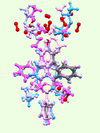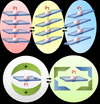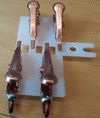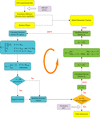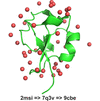issue contents
July 2024 issue

editorial
CHEMISTRY | CRYSTENG
Recent studies published in the Chemistry and crystal engineering section of IUCrJ emphasize developments both in methodology and techniques as well as the diverse range of classes of compounds being studied and of problems being tackled.
scientific commentaries
CHEMISTRY | CRYSTENG
The development of smart, stimuli-responsive materials has received increased attention in the past decade for their applications as sensing technologies. This commentary discusses a timely topical review by Kato [(2024). IUCrJ, 11, 442–452] on the fabrication of multi-stimuli responsive crystals comprised of luminescent platinum(II) complexes, which exhibit intriguing chromic phenomena in response to stimuli.
CHEMISTRY | CRYSTENG
From its conception, X-ray crystallography has provided a unique understanding of the structure, bonding and electronic state of materials, which, in turn, unlocks a means of examining the properties and function of crystalline systems. Using state-of-the-art single-crystal X-ray diffraction, along with UV–Vis spectroscopy and DFT calculations, Zwolenik et al. [(2024). IUCrJ, 11, 519–527] have provided a comprehensive study of the structure–optical property relationship of 1,3-diacetylpyrene with methodologies that are increasingly accessible to non-specialist laboratories.
CHEMISTRY | CRYSTENG
By using complementary experimental methods including in situ high-pressure single-crystal X-ray diffraction and UV–Vis spectroscopy, the intricate connection between solvatochromism and solvatomorphism has been elucidated in a recent publication [Sobczak & Katrusiak (2024). IUCrJ, 11, 528–537]. The connection was demonstrated for an important pigment – Reichardt's dye – with potential applications in nonlinear optoelectronics and molecular pressure sensor development.
topical reviews
CHEMISTRY | CRYSTENG
Platinum(II) complexes exhibit intense luminescence based on their molecular arrangement and chromic luminescence, which is a color change in response to gentle stimuli such as vapor exposure or weak mechanical forces. Both the molecular and the crystal designs for soft crystals are critical to effectively control the chromic phenomenon of platinum(II) complexes.
feature articles
PHYSICS | FELS
This paper proposes a rigorous definition of a periodic structure as an equivalence class of periodic sets under rigid motion, which is a composition of translations and rotations.
BIOLOGY | MEDICINE
The IUCr 75th Congress in Melbourne hosted a workshop on raw data reuse, continuing efforts to promote discussions and plans within crystallography, diffraction and scattering communities. These initiatives build on earlier IUCr funded workshops, aiming to establish ground truth obtained from research results through raw data archiving potential.
NEUTRON | SYNCHROTRON
The 26th IUCr congress held in Melbourne brought discussions on micro-crystallization and in vivo crystallography within structural biology to the forefront, highlighting innovative approaches and collaborative efforts to advance macromolecular research.
research letters
PHYSICS | FELS
In this work, a reversible non-invasive light-induced mesophase transition from lamellar to cubic Pn3m is observed in mixed azobenzene-lipid and phospholipid vesicles using small-angle X-ray scattering.
BIOLOGY | MEDICINE
Traditional structural models of biomolecules typically represent only a single conformational state, even though biomolecules naturally exist in multiple states crucial for their function. Here, we propose enhancements to the macromolecular crystallographic information file (mmCIF) to better capture the complex conformational and compositional heterogeneity of biomolecules that is human- and machine-interpretable.
research papers
NEUTRON | SYNCHROTRON
A novel approach is reported for 6D wide-angle X-ray diffraction tensor tomography characterization based on the concept of virtual reciprocal-space scanning.
ELECTRON CRYSTALLOGRAPHY
Download citation


Download citation


Detailed analysis of the influence of time and temperature on the synthesis of COF-300 showed partial linker degradation but still allowed 3D electron diffraction structure solution using optimized conditions.
CCDC reference: 2321626
CHEMISTRY | CRYSTENG
Download citation


Download citation


A new polymorph of 1,3-diacetylpyrene that is luminescent in the solid state and a prominent negative thermal expansion material has been obtained from its melt. A thorough structural characterization of this new crystal form was performed in a wide temperature and pressure range using single-crystal X-ray diffraction. Structural studies have been combined with steady-state UV–Vis spectroscopy and periodic density functional theory calculations. A previously published methodology of crystal placement in a diamond anvil cell has been successfully applied in predicting optimal 2°AP-β sample orientation, ensuring >80% data coverage and enabling unrestrained Hirshfeld atom refinements for high-pressure structures as well as analysis of anharmonic oscillations.
CHEMISTRY | CRYSTENG
Download citation


Download citation


This work employs the preference of compounds to crystallize at high-pressure in the form of solvates to explore the solvation process and piezo-solvatochromic effects of Reichardt's dye, ET(1). The solute–solvent interactions of this dye affect the optical properties of the dye in various solvents as shown by X-ray diffraction and UV–Vis spectroscopy, revealing applications in nonlinear optoelectronics and molecular pressure sensor development.
PHYSICS | FELS
Fluctuation X-ray scattering measures the correlation of scattered X-rays in diffraction experiments. Here, the Bragg peak intensity from fluctuation X-ray scattering correlations is recovered using an iterative algorithm.
BIOLOGY | MEDICINE
Rational drug discovery and design require a deep understanding of the structure and thermodynamics of protein–ligand interactions. Here, the human carbonic anhydrase family of enzymes and their specific sulfonamide ligands are used to describe binding assays and crystal structures for understanding of protein–compound recognition principles.
NEUTRON | SYNCHROTRON
Scanning WAXS microscopy of a regenerated cellulose textile fiber reveals a radial gradient in the degree of orientation of the crystallite.
CHEMISTRY | CRYSTENG
Download citation


Download citation


A statistical design of experiments approach applied to crystalline sponge analysis enables greater understanding of experimental influences and the development of a novel molecular structure quality grading system.
CCDC references: 2341226; 2342842; 2342843; 2342844; 2342845; 2342846; 2342847; 2342848; 2342849; 2342850; 2342851; 2342852; 2342853; 2342854; 2342855; 2342856; 2342857; 2342858; 2342859; 2342860; 2342861; 2342862; 2342863; 2342864; 2342865; 2342866; 2342867; 2342868; 2342869; 2342870; 2342871; 2342872; 2342873; 2342874; 2342875; 2342876; 2342877; 2342878; 2342879; 2342880; 2342881; 2342882; 2342883; 2342884; 2342885; 2342886; 2342887; 2342888; 2342889; 2342890; 2342891; 2342892; 2342893; 2342894; 2342895; 2342896; 2342897; 2342898; 2342899; 2342900; 2342901; 2343727; 2343728; 2343729; 2343730; 2343731; 2343732;
PHYSICS | FELS
A modified phase-retrieval algorithm has been built on the framework of the relaxed alternating averaged reflection (RAAR) algorithm, incorporating the π-half phase perturbation for weak reflections and the direct-methods based tangent formula for strong reflections in reciprocal space. The modified phase-retrieval algorithm exhibits significantly improved effectiveness and accuracy of various forms of SAD substructure determination to facilitate automatic de novo macromolecular structure determination.
PHYSICS | FELS
A predicted model-aided reconstruction algorithm is proposed for orientation determination and phase retrieval in X-ray free-electron laser single-particle imaging. The predicted model-aided algorithm exhibits significant improvements in the success rate, accuracy and efficiency of the reconstruction process.
NEUTRON | SYNCHROTRON
Here, the n = 2 satellite present for manganese-containing materials and across materials science has been successfully observed by applying the new technique of extended-range high-energy-resolution fluorescence detection (XR-HERFD), developed from high-resolution resonant inelastic X-ray scattering and HERFD, and the spectra have been predicted with new advanced theory.
MATERIALS | COMPUTATION
The development of CPICANN, a novel convolutional self-attention neural network, represents a groundbreaking approach in materials informatics. By leveraging the convolutional self-attention mechanism, CPICANN automates and significantly enhances the efficiency of crystal phase identification from whole X-ray powder diffraction patterns, marking a substantial advancement over traditional time-consuming methods.
letters to the editor
The manuscript `Modeling a unit cell: crystallographic refinement procedure using the biomolecular MD simulation platform Amber' presents a novel protein structure refinement method claimed to offer improvements over traditional techniques like Refmac5 and Phenix. Our re-evaluation suggests that while the new method provides improvements, traditional methods achieve comparable results with less computational effort.


 journal menu
journal menu




 access
access






